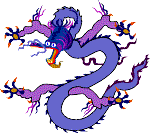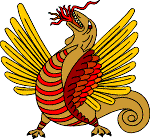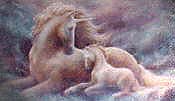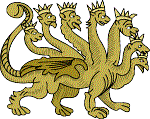 Though
the majority of our medieval friends were illiterate, they were well-acquainted
with the tales of fabulous beasts, partly from word of mouth, but mainly
because these wonderful creatures were common illustrations in the church
windows and common art of the period. Those fortunate enough to be literate
were treated to many an image of a mythical beast, since the illuminators
inserted them into the marginalia and illustrations of the rich Books of
Hours that were the prayerbooks of the period.
Though
the majority of our medieval friends were illiterate, they were well-acquainted
with the tales of fabulous beasts, partly from word of mouth, but mainly
because these wonderful creatures were common illustrations in the church
windows and common art of the period. Those fortunate enough to be literate
were treated to many an image of a mythical beast, since the illuminators
inserted them into the marginalia and illustrations of the rich Books of
Hours that were the prayerbooks of the period.
Mythical creatures have their origins in antiquity, as anyone who met Vergil or Homer during Latin classes knows well. (Please note that the medieval graphics used on this sited frequently do not show the creatures described in the text.)However, there were two strong elements in why they are of particular value in the medieval context. First, even such classically naughty creatures as the centaur were used to illustrate Christian values, allegories, morality and the like. Secondly, Western Europe’s vision of the animal kingdom was expanding, as those trading in the Far East and that vast area known collectively as “India” were bringing back tales of creatures that were no less foreign to the hearers.
There is no question that some mythical beasts, such as the unicorn, were literally believed to be true animals. There are differences of opinion about whether some of our other fabulous creatures were thought to be real, or whether they were artistic expressions. But let us not think, today, that most of them would have appeared too far-fetched to our medieval audience. Such real creatures as the ostrich, hippopatamus, and giraffe are clear illustrations of the divine sense of humour, and certainly appeared less strange than our lovely unicorn. (There is a good basis for believing that the unicorn’s “true self” was the rhinoceros, but I shrink at the thought!)
The ancient work attributed to an author vaguely known as Physiologus (which was attributed to the pen of Saint Ambrose by more pious sorts) was the original source for the “Bestiary”, which contained such entries as this, my personal favourite:
 “Physiologus says that the ant-lion’s father has the shape of a lion and
his mother than of an ant. His father feeds on flesh and his mother on
herbs. These two bring forth the ant-lion, which is a mixture of both,
for his fore part is that of a lion and his hind part that of an ant. Being
thus composed, he can eat neither flesh like his father nor herbs like
his mother, and so he starves to death.”
“Physiologus says that the ant-lion’s father has the shape of a lion and
his mother than of an ant. His father feeds on flesh and his mother on
herbs. These two bring forth the ant-lion, which is a mixture of both,
for his fore part is that of a lion and his hind part that of an ant. Being
thus composed, he can eat neither flesh like his father nor herbs like
his mother, and so he starves to death.”
Though one is unlikely to encounter the ant-lion in medieval art and legend, that his appearance in the bestiary did not cause the literate medieval man to toss the volume aside (indeed, there is evidence that much of the study of the unicorn was inspired by this classic, this being the age where it was honourable to study zoology in libraries) tells us something of his fanciful side. Many of our fabulous beasts, the unicorn among them, were hybrid strains with clear characteristics of two (or more) different species. The ant-lion further reminds us that one’s mind need not speculate about the intricacies of conception and birth, nor the harmony that normally would attend such events.
 Locomotion
amongst such animals could be quite creative. The aphisbaena, whose image
graces a medieval cathedral here and there, was a reptile with heads on
either end. He got about, in either direction, by placing one of the heads
in the other’s mouth and rolling as struck his pleasure.
Locomotion
amongst such animals could be quite creative. The aphisbaena, whose image
graces a medieval cathedral here and there, was a reptile with heads on
either end. He got about, in either direction, by placing one of the heads
in the other’s mouth and rolling as struck his pleasure.
The physical characteristics of other fabulous beasts was quite variable, depending on the author or artist. The siren, whose haunting voice lured many a sailor of literature to his doom, was depicted variously as part woman, part bird; part woman, part fish; or a composite of woman’s body, fish’s tail, and bird’s feet.
 Those
animals which actually exist in nature were not necessarily depicted with
accuracy, and all were given a deeper, moral meaning. The leopard was thought
a living monument to adultery, since he was the offspring of lion and pard.
(Should you wish to know what a pard is, I unfortunately cannot enlighten
you, since, to my knowledge, he is known only as being the naughty sire
of the leopard. However, etymology lovers will enjoy the footnote, contributed
by Simon Gardiner.) The pelican was thought, even by such a great intellectual
as Thomas Aquinas, to be able to revive her dead children by tearing at
her breast until a flow of her blood could cover them - a clear reference
to Christ’s blood purchasing our redemption.
Those
animals which actually exist in nature were not necessarily depicted with
accuracy, and all were given a deeper, moral meaning. The leopard was thought
a living monument to adultery, since he was the offspring of lion and pard.
(Should you wish to know what a pard is, I unfortunately cannot enlighten
you, since, to my knowledge, he is known only as being the naughty sire
of the leopard. However, etymology lovers will enjoy the footnote, contributed
by Simon Gardiner.) The pelican was thought, even by such a great intellectual
as Thomas Aquinas, to be able to revive her dead children by tearing at
her breast until a flow of her blood could cover them - a clear reference
to Christ’s blood purchasing our redemption.
 The
scholar Saint Jerome introduced Christians of the fourth century to several
transplanted beasts that had origins in pagan mythology, and apparently
viewed them as real creatures who were capable of spreading the Word. The
travelling Saint Anthony, who cannot find a policeman or tourist office
for directions while en route to paying a call on the hermit Paul, is ably
assisted by a centaur (half man, half horse), whose foreign accent doesn’t
prevent the task at hand. He then is strengthened by a snack provided by
a satyr (half man, half goat).
The
scholar Saint Jerome introduced Christians of the fourth century to several
transplanted beasts that had origins in pagan mythology, and apparently
viewed them as real creatures who were capable of spreading the Word. The
travelling Saint Anthony, who cannot find a policeman or tourist office
for directions while en route to paying a call on the hermit Paul, is ably
assisted by a centaur (half man, half horse), whose foreign accent doesn’t
prevent the task at hand. He then is strengthened by a snack provided by
a satyr (half man, half goat).
That this would appeal to the medieval mind is not as far-fetched as one might think. Not only the Roman and Greek philosophers, whose wisdom was being accepted in the Middle Ages despite their having been pagans, but, more so, such great saints as Jerome certainly could not have spoken of animals that didn’t roam the earth. All creation came from God’s hands, of course, and could be used for good ends, whether through their own actions or their symbolic value. The centaurs who were bawdy, if not wicked, in Homer’s day could be transformed in the Christian era.
 But,
then, there were exceptions to this rule, what with the reality of evil
in the world. The dragon was a hopeless case,
having been a symbol of the devil since Genesis noted his being the first
confidence man on record. Recalling that God’s punishment to the serpent/dragon
had been to “crawl on its belly” , one may surmise that, before that sentence
was read, this reptile walked upright, and it is so that we see him in
medieval art. He also sports wings, two lion’s claws(or, in some cases,
birdlike feet), and a substantial tail. The great Saint George was faced
with dealing with one of the largest creatures on earth, exceeding even
the 30-foot crocodile in size.
But,
then, there were exceptions to this rule, what with the reality of evil
in the world. The dragon was a hopeless case,
having been a symbol of the devil since Genesis noted his being the first
confidence man on record. Recalling that God’s punishment to the serpent/dragon
had been to “crawl on its belly” , one may surmise that, before that sentence
was read, this reptile walked upright, and it is so that we see him in
medieval art. He also sports wings, two lion’s claws(or, in some cases,
birdlike feet), and a substantial tail. The great Saint George was faced
with dealing with one of the largest creatures on earth, exceeding even
the 30-foot crocodile in size.
Of course, even the dragon had his values, albeit unwittingly on his part. The fear of hell was vastly used to deter the medieval man from sin (or, at least, inspire him to buy an indulgence or two for those already on his conscience). Just in case he didn’t get the point, the local church’s stone carvings undoubtedly would include one of a dragon’s mighty jaws enclosing hordes of those en route to diabolic regions. Considering that dragons were well known to have fiery, poisonous breath, undoubtedly the total effect was quite smart, and the point well taken.
Lions, whose kingship remains unquestioned to this day, often served as symbols of Christ, but equally could be seen in the vein reminiscent of “his opponent, a warring lion” who seeked to devour the faithful. One who happened to encounter a true lion could know which variety he encountered, however, since the friendly sort had curly hair, the wicked ones straight.
 Unrestricted
by the burdens of comparative anatomy, our medieval friends had no problems
accepting the noble gryphon, who alone displayed both fur and feathers.
Our gryphon is part lion, part eagle, and often several other parts that
defy classification.
Unrestricted
by the burdens of comparative anatomy, our medieval friends had no problems
accepting the noble gryphon, who alone displayed both fur and feathers.
Our gryphon is part lion, part eagle, and often several other parts that
defy classification.
The gryphon, much like the lion to whom he presumably has some relation, is alternately treated as a symbol of Christ, noble and kingly, and the antichrist, vicious and destructive.
 No fabulous animal
received more attention than the unicorn. His origins are in antiquity
as well, but as a topic of zoology rather than legend. He came in many
forms, and I can recall seeing a medieval manuscript that actually described
three different species. But let us focus on the medieval unicorn, as best
suited to our context.
No fabulous animal
received more attention than the unicorn. His origins are in antiquity
as well, but as a topic of zoology rather than legend. He came in many
forms, and I can recall seeing a medieval manuscript that actually described
three different species. But let us focus on the medieval unicorn, as best
suited to our context.
The beautiful unicorn combines the physical characteristics of both horse and goat. His horn is unique, not only in his having only one (and in the centre of his brow), but in that it is shaped as a spiral. The learned were aware that, were the horn to be sliced in half, there would be naturally carved images to be found within.
The unicorn's horn was greatly valued, because it had the power of detecting and removing poisons. Place a piece of the horn in poisoned water, and it would bubble at the injustice. The medicinal values of the horn were vast, and a bit sprinkled upon suspect food would counteract the effects of any poisons therein.
The exquisite Unicorn Tapestries, which are on display at The Cloisters, a branch of New York's Metropolitan Museum of Art, well depict the unicorn as a Christian symbol, with strong elements of death and resurrection. At the outset, we see him dipping his horn into the waters, thereby purifying them for use by the various animals that surround the pool. Intentionally or not, the artist placed a hart directly next to the pool, bringing to mind the words of the psalmist, "Like as the hart longs for the running streams, so my soul thirsts for you, O my God."
It was well-known that only a virgin's sweet scent could attract the unicorn, and there was a popular identification of the virgin with the Blessed Virgin Mary. Personally, I always have found that problematic. Considering that the virgin is used as "bait" for the hunters who seek to kill the unicorn, the mental picture of the Blessed Virgin's tricking her Son is repellant. But it would require a very active imagination to identify Mary with the "virgin" who appears in these tapestries. Her alluring, frankly flirtatious look makes us wonder if the unicorn is duped in more ways than one.
 Then, we see the hunters encircle and stab the unicorn, and an association
with those who planned Christ's death can be interpreted. But the strongest
symbol is the final tapestry, where the unicorn, resurrected and with an
expression of majesty, reigns in the shade of the pomegranates. I always
have wondered why the unicorn, in captivity, symbolises Our Lord, but this
reasoning remains unclear.
Then, we see the hunters encircle and stab the unicorn, and an association
with those who planned Christ's death can be interpreted. But the strongest
symbol is the final tapestry, where the unicorn, resurrected and with an
expression of majesty, reigns in the shade of the pomegranates. I always
have wondered why the unicorn, in captivity, symbolises Our Lord, but this
reasoning remains unclear.
I reference these glorious tapestries because, after spending many a Sunday at The Cloisters, they are strongly in my memory. However, this work is by no means a singular, purely artistic interpretation. Identification of the pure, noble unicorn with Christ was very common in the Middle Ages, and perhaps that is why his popularity was great.
 Our
excursion into the "bestiary" gives us a strong notion of symbolic
art and works in the Middle Ages, and I am hoping that this will lead my
readers to explore the subject in greater depth. I hope you have enjoyed
your visit!
Our
excursion into the "bestiary" gives us a strong notion of symbolic
art and works in the Middle Ages, and I am hoping that this will lead my
readers to explore the subject in greater depth. I hope you have enjoyed
your visit!


